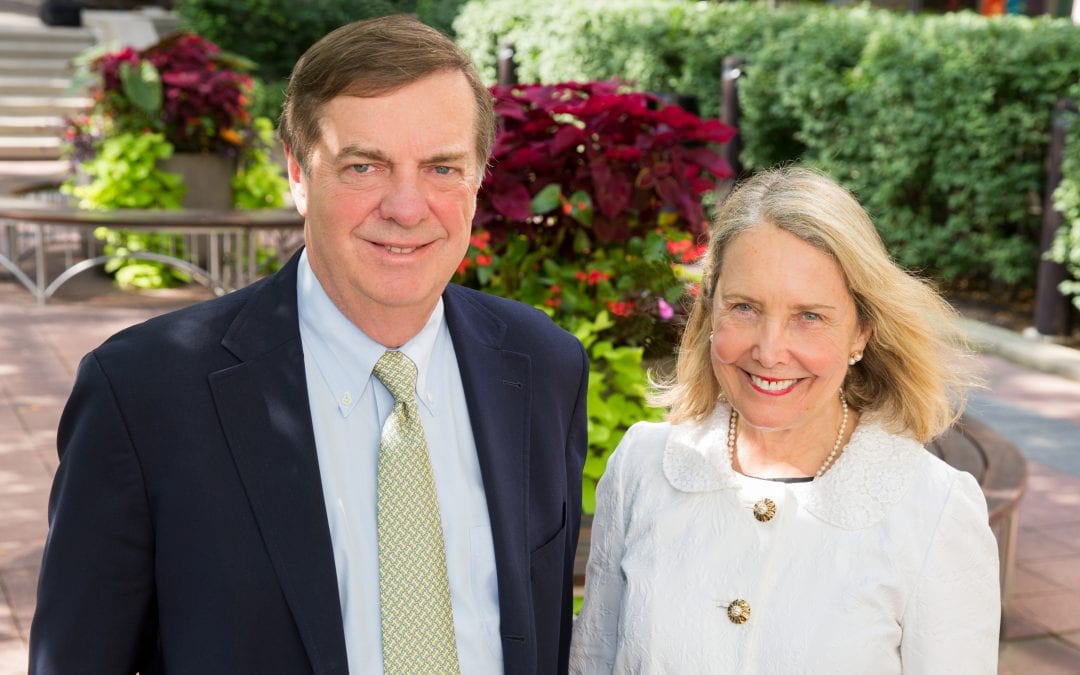When Patrick Martin, Managing Director, Martin Investment Management, LLC, first heard about the idea to form a new institute at Northwestern University that would combine the strengths of different fields of study into one effort focused on finding new drugs and cures for life-threatening diseases and challenging health conditions, he was on a camping trip with his son’s Boy Scout troop.
“Stuart Cornew was a Scoutmaster in Troop 13. I was one of the Assistant Scoutmasters and so was Tom O’Halloran,” said Martin. Both O’Halloran and Cornew were neighbors of Martin and his wife and business partner Sandra Martin, Managing Director, Martin Investment Management, LLC. Over the campfire one evening, he recounts, “they began talking about starting an institute that brought together experts in chemistry, engineering, nanotechnology, biology and all different disciplines into one overall research effort.”
At the time, the group of friends were grappling with the recent cancer diagnosis of a close friend and wanted to find a way to accelerate the development of new drugs and their introduction to the public. From this challenge came their idea that life scientists and clinicians should join forces with chemists, physicists and engineers to develop non-traditional approaches to identifying new biological therapies to solve pressing health challenges and cures for diseases.
Their vision was realized in 2004 when the Chemistry of Life Processes Institute was established at Northwestern University with O’Halloran at the helm and Martin and Cornew, Managing Director, AnswerMine, serving as Executive Advisory Board members. Board members played a leading role in the design of the Richard and Barbara Silverman Hall for Molecular Therapeutics and Diagnostics, which was completed in 2009. The building was specifically designed to foster collaboration and became the home of the Institute, whose membership has grown from 15 tenure-track faculty at the time of building occupancy to its current roster of 61 tenure-track faculty.
As the Martins became better acquainted with the concept of the Institute, they realized other people they knew and respected were also involved; such as the late Barbara Dyson, principal of Dyson, Dyson & Dunn, Inc., and Laura Robertson, Director of Clinical Research, MyoKardia. The Martins wanted to deepen their impact by underwriting promising early stage basic research.
“Initially, it sounded like they were doing a lot of interesting things, working on different discoveries that may or may not happen, but do look promising,” said Patrick Martin. “It was an area that we thought would be a good use of charitable funds because in CLP they really need the money to do the groundwork so they can go after grants.”
Thanks to the generosity of the Martins and other donors, the CLP Cornew Innovation Fund was established to fund pilot projects powered by transdisciplinary teams of scientists. Each year, awards of up to $50,000 are made through a competitive process and finalists are identified by the Executive Advisory Board. In the past eight years, 20 teams of CLP investigators have received Cornew awards resulting in 32 publications, six patents and more than $15 million in new external funding to advance promising projects.
“The Cornew Fund really leverages the ability to get new grants,” says Patrick Martin. “Northwestern, CLP, and Sheila Judge, CLP’s senior director for research, education and administration, have had a great history of obtaining major grants for research, but there isn’t money available at the initial levels. Before you can apply for a grant, you first need the scientific data to back up your hypothesis. It’s hard to say where the success is going to come from when you’re dealing with things like cancer, but the big thing is you’ve got to have a lot of different research approaches because you don’t know for sure which ones are going to be successful.”
Since its founding, the Cornew Fund has opened up critical areas of transdisciplinary research, such as developing new therapeutics for the treatment of Parkinson’s disease, Alzheimer’s and cardiovascular diseases, a non-invasive swab test for early detection of lung cancer, new methods for tissue engineering, new breast cancer probes, and surprising new insights into the earliest stages of fertilization and embryonic development.
CLP research and discovery resonates on a more personal level for the Martins as well.
“Getting older, these are issues we are all concerned about.” says Sandra Martin. “Whether there will be magic bullets in my lifetime or not, I think investing in research that might help future generations is wonderful.”
The Martins were additionally influenced by Patrick’s mother’s cousin, Arloine Neufeld, who graduated from Smith College in 1926 with a degree in chemistry. Neufeld worked for General Mills in Minneapolis and then in secondary education. She was initially responsible for the establishment of the family fund managed by the Martins.
“She was a woman involved in STEM at a very early stage,” says Patrick Martin. “She was always very intellectually curious and interested in new developments technology. I think she would think what they’re doing was fascinating.”
by Lisa La Vallee
